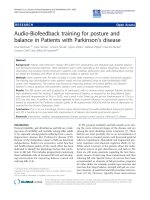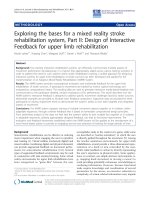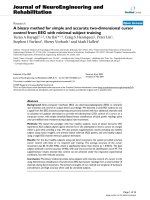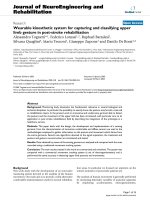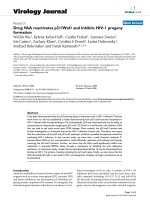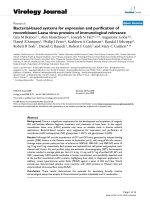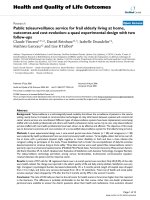Báo cáo hóa học: " Transceiver Design Concept for Cellular and Multispot Diffusing Regimes of Transmission" potx
Bạn đang xem bản rút gọn của tài liệu. Xem và tải ngay bản đầy đủ của tài liệu tại đây (683.05 KB, 9 trang )
EURASIP Journal on Applied Signal Processing 2005:1, 30–38
c
2005 Hindawi Publishing Corporation
Transceiver Design Concept for Cellular and Multispot
Diffusing Regimes of Transmission
S. Jivkova
Central Laboratory of Optical Storage and Processing of Information, Bulgarian Academy of Sciences, 1113 Sofia, Bulgaria
Email:
M. Kavehrad
Center for Information and Communications Technology Research (CICTR), Department of Electrical Engineering,
The Pennsylvania State University, University Park, PA 16802, USA
Email:
Received 25 March 2004; Revised 23 August 2004
A number of attempts have been made in an effort to combine the advantages of line-of-sight and diffuse configurations for
indoor optical wireless communications via sophisticated combinations of elements that are char acteristic for these architectures.
Adifferent approach has been followed in the present investigation, namely, developing a transceiver capable of operating in both
configurations. It is proposed that the transceiver design be based on the utilization of two-dimensional arrays of infrared light-
emitting devices and photodetectors. Basic design parameters of transceiver optics are derived from considerations about link
blockage and system compliance with the unique features of line-of-sight and diffuse methods of transmission.
Keywords and phrases: optical communications, wireless communications, local area networks.
1. INTRODUCTION
It has been more than two decades now since Gfeller and
Bapst [1] suggested that diffusely scattered infrared light
could be utilized as a medium for wireless communications
indoors. Various system configurations for optical wire-
less local area networks have been investigated since then.
They differ in the degree of directionality of the transmit-
ter and receiver and the orientation of the units. The lat-
ter factor underlies the development of two major classes
of link topology: line-of-sight (LOS) links, in which an
LOS path between receiver and transmitter exists, and non-
LOS or diffuse links, which rely on diffuse signal reflec-
tions off the room surfaces. In this paper, the term “dif-
fuse” is used for a link architecture that prohibits the exis-
tence of an LOS between receiver and transmitter regardless
of the transmitter radiation pattern. This is in distinction
from other investigations that apply this term to links that
employ a transmitter with a Lambertian radiation pattern,
even when an unobstructed LOS signal path exists (see, e.g.,
[2]).
This is an open-access article distributed under the Creative Commons
Attribution License, which permits unrestricted use, distribution, and
reproduction in any medium, provided the original work is properly cited.
Line-of-sight architectures
LOS links exhibit low power requirements when transmitted
optical power is concentrated in a narrow beam thus creating
a high power flux density at the receiver. Furthermore, such
links do not suffer from multipath signal distortion. If addi-
tionally a narrow field-of-view (FOV) receiver is used, an effi-
cient optical noise rejection and a high optical signal gain are
achievable [3]. Generally speaking, narrow LOS links (NLOS,
narrow transmit beam and small receiver FOV) are appli-
cable to point-to-point communications only. NLOS links
cannot support mobile users because alignment of receiver
and transmitter becomes necessary. However, elements that
are meant for point-to-point links are being incorporated
into different link configurations in search for better power
efficiency and higher data rates. For example, the so-called
tracked system [4] utilizes a narrow beam transmitter and a
small FOV receiver with the addition of steering and tracking
capabilities.
In LOS optical wireless LANs, the base station is typi-
cally located on the room ceiling. In order to serve multi-
ple mobile users within a relatively large coverage area, the
narrow transmit beam is now replaced by a wide light cone,
which defines a communication cell. This configuration has
been called “cellular” [5]. A large area communication cell
is achieved at the cost of reducing the power efficiency since
Transceiver Design Concept for IR Indoor Communications 31
more launch power is needed to ensure the required power
flux density at the receiver. In cellular configuration, optical
signal is delivered to all the terminals within the light cone.
Communication between portables is accomplished through
a base station, that is, in a star network topology.
An important development in LOS-LANs may be de-
scribed as a merger of cellular and NLOS t racked systems.
The essence is in the utilization of two-dimensional arrays
of emitters and detectors. Base station is placed above the
coverage area. The sources in the transmitter array emit nor-
mally to the plane of the array. Then, an optical system per-
forms spatial-angular mapping, that is, a light beam is de-
flected into a particular angle depending on the spatial posi-
tion of the source in the array. As a result, the communica-
tion cell is split into microcells, each illuminated by a single
light source of the array. At the receiving end, the opposite
transform, angular-spatial mapping is per formed, so that the
optical signal is collected and focused onto a particular de-
tector in the detector array, depending on the angle of ar-
rival. The benefits of introducing detector and emitter arrays
are as follows. Tracking and pointing functions are electron-
ically realized using a spatial-angular-spatial mapping per-
formed by the transceiver optics [2, 6]. Power savings can be
realized by switching off the sources that do not illuminate a
user terminal. Transmitter can be designed so that sources in
the emitter array transmit different data streams, thus signif-
icantly increasing the overall capacity of the communication
system. The pixels in the detector arr ay exhibit low capaci-
tance and small FOV because of their small size. The small
detector capacitance allows for an increase in the transmis-
sion bandwidth and the small FOV reduces the ambient light
reception.
Diffuse architectures
In classical diffuse links [7], base station is located at a desk-
top level and transmitter emits upwards. Usually, transmitter
radiation pattern is Lambertian, therefore the entire room
ceiling and large portions of the walls are illuminated. Since
infrared is diffusely scattered by most room surfaces, signals
reach receiver after multiple reflections off the room walls
and furniture. The immense number of signal paths leads
to signal distortion and, as a consequence, may cause inter-
symbol interference. Another issue of concern is power effi-
ciency. As a rule, diffuse configurations are characterized by
high signal path loss. Therefore, a receiver having a large ef-
fective collection area and a wide FOV must be used. Never-
theless, diffuse links cannot compete with LOS links in terms
of power efficiency. The high optical signal path loss and the
multipath distortion limit the achievable transmission speed
to a few tens of Mbps. On the other hand, while LOS links
can easily be blocked, diffuse links have the advantage of be-
ing ver y robust to shadowing and blockage. Diffuse system
is very well suited for point-to-multipoint connectivity and
with it star, as well as mesh networks can be established.
Yun and Kavehrad [8]proposedadiffuse-type configu-
ration that utilizes a multiple narrow-beam transmitter and
a multibranch angle-diversity receiver, thus a multi-input
multi-output (MIMO) system. This architecture is referred
to as multispot diffusing (MSD). Transmitter projects the
light power in form of multiple narrow beams of equal in-
tensity, over a regular grid of small areas (spots) on a dif-
fusely reflecting surface such as a ceiling. This way, the sig-
nal power is uniformly distributed within the office and the
link quality does not depend on the receiver-transmitter dis-
tance. Each diffusing spot, in this arrangement, may be con-
sidered a secondary light source having a Lambertian radia-
tion pattern. Receiver consists of several narrow FOV receiv-
ing elements aimed at different directions. A good portion
of optical signal power is received by each receiver branch
via a finite number of distinct signal paths; a number equal
to the number of spots seen by the branch. When properly
designed, MSD links are virtually free from multipath signal
distortion. It has been shown that the communication chan-
nel exhibits a vast bandwidth (greater than 2 GHz on a 3 dB
basis [9]) and can be considered virtually ideal at data rates
of hundreds of Mbps. The nar row FOV of the receiver ele-
ments provides means to decrease the level of ambient light
reception utilizing narrow spectral bandwidth optical filters
and by spatial separation of desired signal from strong ambi-
ent light sources. Receiver consists of more than one element
inordertocoverseveraldiffusing spots, thus ensuring un-
interrupted communication in case some of the transmitter
beams are blocked. Additionally, a multiple-element receiver
provides diversity, thus it allows combining the output sig-
nals from different receiver elements using effective combin-
ing techniques.
Like in LOS links, the latest development in quasidiffuse
links is the use of emitter [10]anddetectorarrays[8, 10, 11].
Utilization of a compact two-dimensional array of semicon-
ductor light sources allows for a reconfigurable transmitter
output. Each light source in the array is responsible for cre-
ating a single diffusing spot on the room ceiling, that is,
the number of sources equals the number of diffusing spots
needed to cover the communication cell. If there is no need
for optical signal within certain parts of the communication
cell, the corresponding light sources are switched off.Thus,
the system provides only the active users with signal and
saves some power by not distributing optical signal where it
is not needed. With such a transmitter design, independent
communication channels (different information streams are
launched through different diffusing spots) are feasible, thus
providing a means for spatial diversity. Receiver design is also
very similar to the one that has been proposed for LOS sys-
tems. Such a receiver possesses inherent angle diversity and
the small FOV associated with a single detector pixel ensures
an optimal ratio between signal and optical noise level at a re-
ceiving element. In contrast to LOS configuration, a user ter-
minal communicates with base station through several com-
munication channels whose number equals the number of
diffusing spots within the overall receiver FOV.
The fundamental difference in signal propagation envi-
ronments in LOS and diffuse links determines the advantages
and the drawbacks of these link configurations. Despite all
the efforts of a number of research groups over the years, LOS
links still have benefits that none of the proposed non-LOS
32 EURASIP Journal on Wireless Communications and Networking
topologies offers, and vise versa. On the other hand, both
LOS and diffuse configurations have evolved through the
years and recent developments show that the researches have
arrived at surprisingly similar transceiver optical designs.
Therefore, a good direction for the future research efforts
would be designing a transceiver that is capable of operat-
ing in both regimes, that is, in both LOS and non-LOS ge-
ometries. This is especially important for the portable units,
which should be able to communicate with both types of base
stations and with other portables. The aim of this paper is to
make the first step towards the optical design of such a uni-
versal transceiver.
2. TRANSCEIVER PARAMETERS
AND LINK BLOCKAGE
In both cellular and MSD architectures, a large coverage area
is desired. This imposes severe requirements on the transmit-
ter and receiver optics. Wide receiver FOV and large emis-
sion angle are not routinely achieved. On the other hand,
it is unnecessary to increase the coverage area beyond cer-
tain size because of the increased probability of link block-
age. Even when care has been taken of the permanent block-
ing objects like furniture and partitions, the link still can be
blocked by the people on the move. In the present investi-
gation, the blockage of cellular and MSD links by people is
carefully studied in order to ease the requirements on the
transceiver optical system design.
Any optical wireless link is a subjec t to shadowing,
and even blockage, caused by moving or stationary objects.
Blockage and shadowing mig h t be an important degrading
factor for the system performance. When a link is blocked,
the information transfer ceases. Therefore, special care must
be taken to prevent link blockage and ensure uninterrupted
communications.
Shadowing effects depend on the particular interior of an
office. It is extremely difficult to generalize an investigation
of these effects. Because the shadowing or blockage by furni-
ture is easier to predict and avoid, we are mainly concerned
with the blockage caused by people. The blocker is assumed
to be a tall person who is modeled as having a lateral dimen-
sion of 50 cm and a height of 100 cm above communicat ion
cell floor. Cell floor is at a desktop level and the cell height
is defined as the distance along a vertical line from the room
ceiling to the desktop level. All portable units are assumed
at the cell floor level. Base station in an LOS configuration
is placed on the room ceiling while in MSD configuration it
is on a desk. In the following analysis, it is assumed that a
person cannot be closer than 50 cm to a portable unit (or a
base station in the case of MSD). This restriction is justified
by the fact that the portable terminals are usually placed on a
desk, so that the area in close proximity to the portable unit
is readily occupied by the desk.
Transmitter radiation angle
Consider first the LOS configuration depicted in Figure 1.
Maximum semiangle, Φ, at which a base station can transmit
Φ
LOS
BS
H
R
Obstacle
h
PU
r
0
Figure 1: Cellular architecture: BS (base station), PU (portable
unit), Φ
LOS
(maximum transmit semiangle), H (communication
cell height), R (communication cell radius), h (blocker height), r
0
(minimum possible blocker-portable unit distance).
r
FOV
DS
H
FOV
Obstacle
h
Φ
MSD
Rx Tx
r
0
R
Figure 2: MSD architecture: Rx (receiver), Tx (transmitter), DS
(diffusing spot), Φ
MSD
(maximum transmit semiangle), FOV (re-
ceiver acceptance half angle), r
FOV
(radius of the circular area in the
ceiling that is seen by the receiver), H (communication cell height),
R (communication cell radius), h (blocker height), r
0
(minimum
possible blocker-portable unit distance).
with full connection availability, is determined by
Φ
LOS
= arctan
r
0
h
,(1)
where r
0
is the minimum possible blocker-portable unit dis-
tance, and h is the blocker height (above the communica-
tion cell floor). With r
0
= 50 cm and h = 100 cm, the maxi-
mum transmitter emission semiangle is 27
◦
. At larger angles,
a moving person may block the LOS between a terminal and
a base station.
In d iffuse architectures, there is a restriction about the
angle by which the transmitted light beams strike the reflect-
ing surface. Diffuse links rely on diffusereflectionsfromre-
flecting surfaces. Increasing the angle of incidence above 60
◦
,
the reflection pattern of typical office surfaces (ceiling and
walls) deteriorates from Lambertian reflector and exhibits
strong specular reflections [1]. According to the analysis pro-
vided in [10], the maximum semiangle of transmitter radi-
ation, φ
MSD
, is further restricted down to 45
◦
by consider-
ing link shadowing and blockage (see Figure 2). It has been
Transceiver Design Concept for IR Indoor Communications 33
2R
2R
Figure 3: A large rectangular area covered by sets of square or hexagonal communication cells of equal largest horizontal size. In the case of
square cells, 24 base stations are needed as contrasted to only 20 base stations in the case of hexagonal cells.
shown that with this restriction standing or moving people
cannot block the link although some shadowing is possible.
That is, a person near the base station might block some but
not all transmitter beams that produce diffusing spots within
receiver FOV. Furthermore, the power penalty due to shad-
owing has been computed and it does not exceed 0.1dB in
99% of the cases.
Receiver acceptance angle
In order to operate at different angles o f acceptance i n cellu-
lar and MSD configurations, receiver optical system will nec-
essarily be quite complex. Therefore, it is desirable that the
receiver has a fixed value of its FOV instead of a variable one.
From Figure 1,itisevidentthatinLOSconfigurationthe
receiver acceptance angle must be wide enough to encompass
the base station at any receiver position within the commu-
nication cell. Then, the receiver FOV (half acceptance angle)
must comply with the inequality FOV ≥ Φ
LOS
= 27
◦
.Set-
ting a safety margin of 10% leads to a value of about 30
◦
:
FOV = 1.1Φ
LOS
= 29.7
◦
.
In [10], it has been shown that receiver FOV in MSD con-
figuration must be at least 25
◦
. In other words, any value that
is larger than 25
◦
is acceptable.
Thus, a receiver FOV value of 30
◦
would satisfy the re-
quirements of both communication architectures.
3. TRANSMITTER RADIATION PATTERN
The communication systems under consideration are bound
to operate in offices and other closed a reas that have, in
general, a rectangular form. The easiest and the most nat-
ural way to provide the service to all users in a rectangu-
lar room is to split the room in a set of square commu-
nication cells. However, when the largest horizontal size of
the communication cell is restricted (e.g., by considerations
regarding link blockage) a square cell covers a smaller area
than the corresponding circular communication cell. On the
other side, circular cells must partially overlap in order to
avoid gaps. A h oneycomb-like structure of communication
cells provides the most efficient cov erage. In order to serve a
given area, one would need a larger number of base stations
forming square communication cells as compared to the ones
that produce hexagonal cells. This is illustrated in Figure 3.
r
FOV
a
Figure 4: Triangular lattice of diffusing spots to define a hexagonal
communication cell. The lattice spacing, a, must be smaller than the
radius, r
FOV
, of the circular area seen by the receiver.
Both square and hexagonal cells correspond to the same
maximum transmission angle, that is, their maximal lateral
dimensions, denoted by 2R, are equal. The corresponding ar-
eas of a single communication cell are A
square
= (2R)
2
/2and
A
hexagon
= 3
√
3(2R)
2
/8, and their ratio is A
hexagon
/A
square
=
1.3. In Figure 3, a large rectangular area is covered by 24
square cells, that is, 24 base stations are needed to serve the
whole area. In the case of hexagonal communication cells,
the number of base stations is reduced to 20. In view of this,
the following analysis is concerned with transmitter radia-
tion pattern that produces a hexagonal communication cell.
Transmitter pattern in multispot diffusing configuration
In MSD configuration, transmitter must emit multiple nar-
row light beams towards the room ceiling. These light beams
illuminate small a reas on the ceiling, called diffusing spots.
The most natural way of creating a hexagonal communica-
tion cell is to have diffusing spots on a triangular mesh, as it
is shown in Figure 4. Transmitter optics collimates and de-
flects the beams from the source arr ay to produce the desired
triangular spot lattice. Receiver must always see more than
one spot to ensure uninterrupted communications in case of
shadowing. Therefore, the radius, r
FOV
, of the circular area
on the room ceiling that is seen by the receiver must be larger
34 EURASIP Journal on Wireless Communications and Networking
R
MSD
R
MSD
a
a
(a)
Source array
Collimating and
deflecting optics
(b)
Figure 5: (a) A hexagonal communication cell made of a triangular lattice of diffusing spots. The spots can be viewed as arranged in rings
around the central diffusing spot. The side of the hexagonal communication cell, R
MSD
, is an integer number times the lattice spacing, a.
(b) Schematic of the proposed transmitter optics. The role of the optical system is to collimate and redirect the source beams in appropriate
directions to create a light spots lattice.
than the spots lattice spacing, a:
r
FOV
= H tan FOV >a,(2)
where H is the communication cell height, that is, the dis-
tance from the room ceiling to the desktop level.
The lattice spacing can be expressed in terms of the hor-
izontal communication cell size: a = R
MSD
/n.Here,R
MSD
is the hexagonal cell side and n is the number of rings of
spots around the central diffusing spot (see Figure 5a). Since
R
MSD
= H tan Φ
MSD
,
a =
H
n
tan Φ
MSD
. (3)
Then, using the inequality (2), a condition about the in-
teger n is obtained:
H tan FOV >
H
n
tan Φ
MSD
,
n>
tan Φ
MSD
tan FOV
=
tan 45
◦
tan 30
◦
= 1.7(i.e.,n ≥ 2).
(4)
The total number of diffusing spots or, correspondingly,
the total number of light sources in the emitter array is
N = 1+
n
k=1
6k. The outputs of these light sources must
be collimated and deflected to appropriate angles to create
a triangular mesh of diffusing spots on the room ceiling, as
shown in Figure 5.
Transmitter pattern in cellular configuration
In cellular configuration, the communication cell is split into
a number of hexagonal microcells, as shown in Figure 6a.
The resultant shape of the cell is close to a hexagon and mul-
tiple cells can adjoin without gaps.
The beam from each individual light source in the emit-
ter array must be flattened, shaped, and deflected to illumi-
nate unifor mly the desired hexagonal area of a particular mi-
crocell. Apparently, transmitter optical system will necessar-
ily differ somewhat from the one that is utilized in an MSD
system. To facilitate the design of a transmitter optics that
will serve both cellular and diffuse systems, the same beam
deflection angles as in MSD configuration are retained. Then,
as shown in Figure 6b, flattening and shaping of the light
beams can be done using an additional diffractive optical el-
ement (see, for e.g., [12]) that will be exerted or activated
when the system is to operate in LOS regime.
Further, in order to satisfy the requirement for the maxi-
mal radiation semiangle of 27
◦
,notallN sources in the emit-
ter array should be active in the LOS regime. We denote the
number of sources that are used in LOS regime of opera-
tion by M, and the number of rings of hexagonal microcells
around the central one by m. Again, these two quantities are
interdependent through M = 1+
m
k=1
6k.FromFigure 6a,it
can be seen that the lateral size of the communication cell can
be expressed in terms of the diffusing spots lattice spacing in
MSD regime:
R
LOS
=
m +
1
2
a,(5)
where a is given by (3). On the other side,
R
LOS
= H tan Φ
LOS
. (6)
Then, using (3) through (6), the possible values for m are
obtained:
m = n
tan Φ
LOS
tan Φ
MSD
− 0.5 ≈ 0.5n − 0.5 = 0.5(n − 1),
n = 2,3, 4,
(7)
Note that m must be an integer. Equation (7) gives values for
m that are close enough to an integer for the odd values of n.
Transceiver Design Concept for IR Indoor Communications 35
R
LOS
a
b
(a)
Source array
Collimating and
deflecting optics
Flattening and
shaping optics
(b)
Figure 6: (a) A communication cell made of hexagonal microcells. The distance between the centers of two neighboring microcells, a,
equals the distance between two neighboring diffusing spots in the case of MSD configuration. 2R
LOS
is the maximal lateral size of the
communication cell; b is the side of the hexagonal microcell. (b) Schematic of the proposed transmitter optics. The role of the optical system
is to flatten, shape, and redirect the source beams so that adjoining hexagonal areas are unifor mly illuminated.
Thus, the smallest number of sources in the emitter array that
will serve successfully both cellular and diffuse systems is ob-
tained for n = 3:
N = 1+
3
k=1
6k = 37. (8)
For n = 3, m = 1andM = 7. The number of sources that
are active in diffuse regime of operation is 37, while only 7 of
them are needed in cellular regime. The optimum number
of sources in the emitter array is not necessarily the small-
est one. This should be a subject to further investigation al-
though throughout the rest of this paper N = 37 is assumed.
4. LARGE OFFICE SPACE COVERAGE
When the office space that is to be covered is larger than
the communication cell size, more than one base stations
must be used to provide the service to all users, as shown in
Figure 3. Since the communication cell size in MSD is larger
as compared to cellular configuration, a larger number of
base stations are needed for LOS communications. The dif-
ference in the base stations density may roughly be estimated
by comparing the communication cells areas A
LOS
and A
MSD
:
A
LOS
= 7A
µ cell
,(9)
where A
µ cell
is the area of a single microcell in LOS regime;
A
MSD
≈ 37A
µ cell
≈ 5A
LOS
. (10)
Evidently, a much smaller number of base stations work-
ing in diffuse regime, as compared to their number in LOS
regime, are re quired for the cove rage of a given o ffice space.
Expressed in terms of the communication cell height, the
microcell area is
A
µ cell
=
3ab
2
=
√
3
2
H
2
tan
2
Φ
MSD
n
2
, (11)
where b = a/
√
3 (see Figure 6a) and relation (3)hasbeen
taken into account. Thus, the density of base stations is in-
versely proportional to the second power of the office height:
1
A
LOS
∼
1
A
µ cell
∼
1
H
2
,
1
A
MSD
∼
1
A
µ cell
∼
1
H
2
. (12)
In other words, the higher the office, the smaller the number
of base stations required.
In the case of hexagonal communication cells, the base
stations are placed in the knots of a triangular mesh. The
base stations grid spacing depends on the room height and,
certainly, is different in LOS and diffuse architectures. In
Figure 7,itisdenotedbyS
LOS
and S
MSD
for the cases of cellu-
lar and MSD configurations, respect ively. S
LOS
and S
MSD
can
easily be calculated if the office height is known:
S
LOS
=
(2a)
2
+(3b)
2
=
(2a)
2
+
3
a
√
3
2
=
√
7a =
√
7
H tan Φ
MSD
n
,
S
MSD
=
(5a)
2
+
4
√
3a
2
2
=
√
37a =
√
37
H tan Φ
MSD
n
.
(13)
For n = 3andΦ
MSD
= 45
◦
, the base stations grid spacing is
S
LOS
= 0.9H and S
MSD
= 2H for the two architectures under
consideration, respectively.
36 EURASIP Journal on Wireless Communications and Networking
BS2
S
LOS
BS1
BS3
(a)
BS2
S
MSD
BS1
BS3
(b)
Figure 7: Illumination of three adjoining communication cells is shown f or the case of (a) a cellular configuration and (b) an MSD configu-
ration. The positions of the base stations, BSs, are projected on the illumination plane (desktop level in (a) and ceiling in (b)). The distances
between the neighboring base stations are denoted by S
LOS
and S
MSD
,respectively.
5. SIGNAL PATH LOSS
Optical wireless communications are characterized by a high
signal path loss. Therefore, receiver must necessarily exhibit
a large receiving area. On the other hand, if a large area pho-
todetector were used, the high capacitance associated with it
would greatly reduce t he receiver bandwidth.
Instead of a single large-area detector, a two-dimensional
array of photodetectors is utilized, as has been proposed
for the first time in [8]. A common optics serves all pix-
els in the detector array (see Figure 8). This way, the ef-
fective receiving area, which is the effective entrance aper-
ture of the lens system, is large and collects a good por-
tion of the optical signal. At the same time, the photode-
tector pixel, that actually receives the signal and converts it
into an electrical one, has a small area, therefore a small ca-
pacitance. As a consequence, receiver can support high bit
rates while receiving signals within a wide FOV. For exam-
ple, in our recent three-lens optical design of an imaging
receiver, presented in [10], we have achieved a full accep-
tance angle of 50
◦
, an entrance aperture diameter of 30 mm,
and an image spot size between 1.7 mm and 2.48 mm, de-
pending on the angle of signal arrival. The seg mented de-
tector consists of 37 hexagonal pixels, each having a 2.8 mm
side.Thus,atotalimageareaof750mm
2
is covered while
the active receiving element has a fairly small area of about
20 mm
2
.
Another advantage of utilizing a detector array is the ca-
pability of such a receiver to distinguish between signals ar-
riving from different directions, that is, different diffusing
spots in the case of MSD or different base stations in the case
of a cellular architecture. This is because receiver optical sys-
tem actually performs angular-spatial mapping, as shown in
Figure 8. A very small solid acceptance angl e corresponds to
each pixel in the detector array, so that optical signal power
Filter
Lens system
Photodetector
array
Figure 8: Receiver optical front end performs angular-spatial map-
ping. The lens system focuses light impinging at different angles
onto different pixels in the detector array.
is focused onto a particular detector depending on the signal
angle of incidence.
Opticalsignalpathlossisquitedifferent for LOS and dif-
fuse architectures; it is higher in the case of diffuse config-
uration. In the following, it is shown that this difference is
entirely within the capabilities of the commonly used photo-
diodes at the receiver to accommodate.
In MSD, received optical power that is launched through
a single diffusing spot, that is, a single source in the emitter
Transceiver Design Concept for IR Indoor Communications 37
Table 1: Representative link budget.
Cellular topography MSD topography
Wavelength > 1400 nm > 1400 nm
Eye-safe transmit power per emitting element +10 dBm +10 dBm
Opticalpathlossatcelledge −48 dB −66 dB
Receiver optics loss (filter and Fresnel losses) −2dB −2dB
Optical concentrator gain (3 cm entrance aperture diameter, 3 mm image spot diameter) +20 dB +20 dB
Received optical power −20 dBm −38 dBm
Receiver sensitivity at 155 Mbps (according to [2])
−28.5 dBm (PIN),
−43.5 dBm (avalanche)
−28.5 dBm (PIN),
−43.5 dBm (avalanche)
Irradiance at a 10 mm
2
receiving pixel −10 dBm/cm
2
−28 dBm/cm
2
Required irradiance at 100 Mbps (according to [3]) −30 dBm −30 dBm
array, is
P
MSD
=
P
0
ρ cos θ
πr
2
A
rec
cos θ =
P
0
ρ cos
4
θ
πH
2
A
rec
, (14)
where P
0
is the launch optical power, ρ is the ceiling re-
flectance, θ is the angle between a vertical line and the line-
of-sight between the receiver and the diffusing spot, r =
H/ cos θ is the distance between the receiver and the diffusing
spot, and A
rec
is the receiver effective area. Received power is
minimal when the diffusing spot appears at the edge of the
receiver FOV, that is, when θ = FOV:
P
min
MSD
=
P
0
ρ cos
4
FOV
πH
2
A
rec
. (15)
Received optical power in cellular configuration depends
on the size of the microcells:
P
LOS
=
P
0
A
µ cell
A
rec
cos θ, (16)
where P
0
is the launch optical power by the source in the
emitter array that illuminates the particular microcell and θ
is the angle of signal arrival. The received power is maximal
at normal incidence, that is, for θ = 0.
Then, the maximum received optical power in a cellular
configuration is
P
max
LOS
=
2
√
3
P
0
n
2
H
2
tan
2
Φ
MSD
A
rec
. (17)
The ratio between the two extreme values, the maximum
received optical power in cellular regime and the minimum
received power i n MSD regime, expressed in dB, i s
D
= 10 log
10
P
max
LOS
P
min
MSD
= 10 log
10
2
√
3
πn
2
ρ tan
2
Φ
MSD
cos
4
FOV
(18)
and its value is 18.6dB for n = 3, Φ
MSD
= 45
◦
,FOV= 30
◦
,
and ρ = 0.8. The actual value of this ratio would be some-
what larger due to the dependence of the optical concentra-
tor gain on the signal direction of arrival.
Note that in both configurations received optical power
is inversely proportional to the squared communication cell
height, so that D does not depend on the office size.
An exemplary link budget is given in Table 1.Itassumes
a wavelength longer than 1400 nm, at which 10 mW optical
power can safely be launched [13]. At shorter wavelengths,
holograms can be employed in order to make the transmitter
eye-safe (see, e.g., [14, 15]).
6. CONCLUDING REMARKS
The basic idea that underlies the present investigation is to
bring together the two most promising configurations for
optical wireless networks indoors, namely, cellular line-of-
sight and MSD configurations. This is attempted through
developing a system that would be capable of operating in
both configurations rather than a sophisticated combination
of the architectures themselves. The latter has been tried be-
fore with limited success. Therefore, the idea is to redirect
the research efforts and to develop a transceiver capable of
operating in both cellular and MSD regimes. As a first step
towards achie ving this goal, it is proposed that transceiver
design is based on utilization of two-dimensional arrays of
infrared light emitting devices and photodetectors. Basic de-
sign para meters of transceiver optics are derived from con-
siderations on link blockage and system compliance with the
unique features of LOS and diffuse regimes of transmission.
Currently, a detailed design of transceiver optical system is
under way. For this purpose, conventional optics, diffractive,
and holographic solutions are considered. Certainly, a com-
promise b etween transceiver complexity, cost, microcell size
(in LOS regime), number of independent channels (estab-
lished between two communicating devices in MSD regime),
receiving pixel size, and so forth, has to be sought.
REFERENCES
[1] F. R. Gfeller and U. H. Bapst, “Wireless in-house data com-
munication via diffuse infrared radiation,” Proc. IEEE, vol. 67,
no. 11, pp. 1474–1486, 1979.
[2] V. Jungnickel, A. Forck, T. Haustein, U. Kruger, V. Pohl, and
C. von Helmolt, “Electronic tracking for wireless infrared
communications,” IEEE Transactions on Wireless Communi-
cations, vol. 2, no. 5, pp. 989–999, 2003.
38 EURASIP Journal on Wireless Communications and Networking
[3] A. M. Street, P. N. Stavrinou, D. C. O’Brien, and D. J. Ed-
wards, “Indoor optical wireless systems—a review,” Optical
and Quantum Electronics, vol. 29, pp. 349–378, 1997.
[4] D. R. Wisely, “A 1 Gbit/s optical wireless tracked architecture
for ATM delivery,” in Proc. IEE Colloquium Optical Free Space
Communication Links, pp. 14/1–14/7, London, UK, February
1996.
[5] M. J. McCullagh and D. R. Wisely, “155 Mbit/s optical wireless
link using a bootstrapped silicon APD receiver,” Electronic
Letters, vol. 30, no. 5, pp. 430–432, 1994.
[6] D.C.O’Brien,G.E.Faulkner,K.Jim,etal.,“High-speedinte-
grated transceivers for optical wireless,” IEEE Commun. Mag.,
vol. 41, no. 3, pp. 58–62, 2003.
[7] J. R. Barry, Wireless Infrared Communications,KluwerAca-
demic, Boston, Mass, USA, 1994.
[8] G. Yun and M. Kavehrad, “Spot-diffusing and fly-eye receivers
for indoor infrared wireless communications,” in Proc. IEEE
International Conference on Selected Topics in Wireless Com-
munications, pp. 262–265, Vancouver, BC, Canada, June 1992.
[9] S. Jivkova and M. Kavehrad, “Receiver designs and channel
characterization for multi-spot high-bit-rate wireless infr ared
communications,” IEEE Trans. Commun., vol. 49, no. 12, pp.
2145–2153, 2001.
[10] S. Jivkova, B. A. Hristov, and M. Kavehrad, “Power-efficient
multispot-diffuse multiple-input-multiple-output approach
to broad-band optical wireless communications,” IEEE Trans.
Veh. Technol., vol. 53, no. 3, pp. 882–889, 2004.
[11] P. Djahani and J. M. Kahn, “Analysis of infrared wireless links
employing multibeam transmitters and imaging diversity re-
ceivers,” IEEE Trans. Commun., vol. 48, no. 12, pp. 2077–2088,
2000.
[12] J. J. Yang and M. R. Wang, “Analysis and optimization on
single-zone binary flat-top beam shaper,” Optical Engineering,
vol. 42, no. 11, pp. 3106–3113, 2003.
[13] IEC, “Safety of laser products—part 1: Equipment, classifica-
tion, requirements and user’s guide,” International Standard
IEC 825-1, 1993.
[14] M. R. Pakravan, E. Simova, and M. Kavehrad, “Holographic
diffusers for indoor infrared communication systems,” in
Proc. IEEE Global Telecommunications Conference (GLOBE-
COM ’96), vol. 3, pp. 1608–1612, London, UK, November
1996.
[15] P. L. Eardley, D. R. Wisely, D. Wood, and P. McKee, “Holo-
grams for optical wireless LANs,” IEE Proc. Optoelectronics,
vol. 143, no. 6, pp. 365–369, 1996.
S. Jivkova received the M.S. degree in
physics in 1985 from the University of Sofia,
Bulgaria, and the Ph.D. degree from the
Bulgarian Academy of Sciences in 1992.
She is currently a Research Associate with
the Central Laboratory of Optical Storage
and Processing of Information, the Bul-
garian Academy of Sciences, and a Post-
doctoral Fellow with the Center for In-
formation and Communications Technol-
ogy Research (CICTR), the Pennsylvania State University. Her
fields of research include optical wireless communications, dig-
ital and optical holography, photorefractive materials, photonic
band-gap structures, and so forth. She has published a large num-
ber of papers in the most prestigious international journals in
optics.
M. Kavehrad received the Ph.D. degree
from Polytechnic University, Brooklyn, New
York, November 1977, in electrical en-
gineering. Between 1978 and 1989, he
worked on telecommunications problems
for Fairchild Industries, GTE (Satellite and
Labs), and AT&T Bell Laboratories. In 1989,
he joined the Electrical Engineering Depart-
ment, University of Ottawa, as a Full Pro-
fessor. Since January 1997, he has been with
the Electrical Engineering Department, the Pennsylvania State Uni-
versity, as a WL Weiss Chair Professor and Founding Director of
the Center for Information and Communications Technology Re-
search. He is a Fellow of the IEEE for his contributions to wire-
less communications and optical networking. He has over 250 pub-
lished papers, several book chapters, books, and patents in these ar-
eas. His current research interests are in wireless communications
and optical networks. He is a former Technical Editor for the IEEE
Tr ansactions on Communications, IEEE Communications Maga-
zine, and the IEEE Magazine of Lightwave Telecommunications
Systems. Presently, he is on the Editorial Board of the Interna-
tional Journal of Wireless Information Networks. He served as the
General Chair of leading IEEE conferences. He has chaired, orga-
nized, and been on the advisory committee for several international
conferences.

